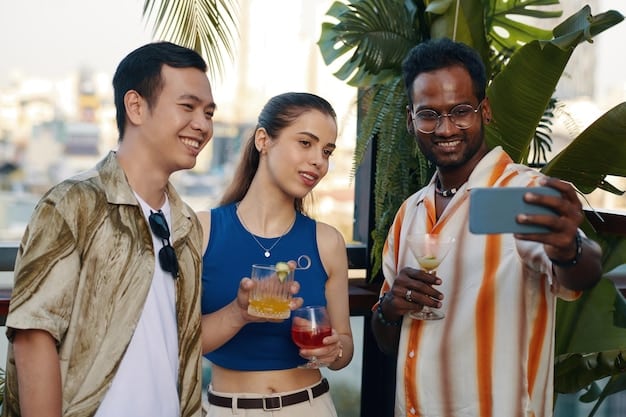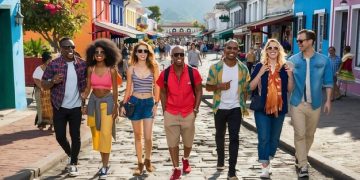Travel Influencer Marketing: Justifying ROI with Industry Data

Travel influencer marketing presents a complex ROI landscape, where recent industry data is crucial for assessing the true value and impact of collaborations between travel brands and influencers, allowing for informed marketing decisions.
Is travel influencer marketing: is the ROI justified based on recent industry data? That’s the burning question on every travel brand’s mind. Recent industry data offers critical insights into calculating the ROI of travel influencer collaborations, helping brands determine if these partnerships are truly worth the investment.
Understanding Travel Influencer Marketing
Travel influencer marketing has transformed how travel brands connect with their audiences. Instead of relying solely on traditional advertising, brands are partnering with influencers to showcase destinations, accommodations, and travel experiences.
This form of marketing leverages the trust and authenticity that influencers have cultivated with their followers, often leading to higher engagement and conversion rates. But how do you measure the effectiveness of these campaigns?
The Rise of Travel Influencers
The proliferation of social media platforms like Instagram, YouTube, and TikTok has given rise to a new breed of marketers: travel influencers. These individuals create content that inspires and informs their followers, often partnering with brands to promote travel-related products and services.
Benefits of Influencer Marketing
Engaging with influencers can bring several benefits for travel brands, from extended reach and increased brand awareness to boosts in website traffic and direct sales. However, it’s essential to consider how these benefits stack up against the marketing spend.
- Increase Brand Awareness: Influencers expand reach to new and engaged audiences.
- Drive Website Traffic: Compelling content leads followers to brand websites.
- Boost Direct Sales: Authentic endorsements encourage purchase decisions.

The key is to critically analyze the numbers, ensuring that influencer engagements translate into tangible returns. Understanding the basics is just the first step to optimizing influencer marketing strategy for better ROI.
Analyzing Industry Data for ROI Insights
To accurately assess the ROI of travel influencer marketing, one must delve into recent industry data. This data offers benchmarks, performance insights, and trends that can shape marketing strategies and determine realistic expectations.
Industry reports, case studies, and analytics tools provide a wealth of information on campaign performance, audience demographics, and engagement rates, all vital for informed decision-making.
Key Metrics to Consider
Several metrics play a crucial role in evaluating the ROI of influencer marketing campaigns, including engagement rate, reach, website traffic, and conversion rates.
Focusing on metrics tied to key business objectives provides a clearer picture of whether the marketing spend is translating into valuable outcomes.
Tools for Tracking ROI
Tracking influencer campaign performance effectively relies on a range of analytics tools, from platform-specific metrics to dedicated influencer marketing platforms. These tools provide data-driven insights that enable marketers to refine their strategies and maximize returns.
- Social Media Analytics: Monitor engagement directly on platforms like Instagram.
- Influencer Marketing Platforms: Use specialized tools to assess campaign performance.
- Website Analytics: Track referral traffic and conversions driven by influencers.
By leveraging these tools to consistently monitor marketing activities, businesses can make real-time adjustments that optimize their influencer marketing investments. This proactive approach is key to maximizing returns.
Evaluating the Costs of Travel Influencer Marketing
Before diving into travel influencer marketing, it’s essential to fully understand the various costs involved. Influencer fees, content production expenses, and agency costs can significantly impact the campaign’s overall budget.
Having a clear understanding of these costs helps in formulating a budget that aligns with marketing objectives and ensures maximum ROI.
Influencer Fees and Compensation Models
Influencer fees depend on factors such as reach, engagement, content type, and the influencer’s niche. Compensation models typically include a flat fee payment, pay-per-post, affiliate programs, or a combination of these.
Aligning the compensation structure with the expected outcomes is vital in achieving a favorable ROI.
Content Production Costs
Content creation is an important aspect of influencer marketing, and its costs can vary depending on complexity, equipment, and resources required. From photography and videography to copywriting and graphic design, these costs should be factored into the budget.

Budgeting for professionally produced content can enhance the campaign’s appeal and effectiveness.
- Photography and Videography: Outlay costs for professional recording.
- Copywriting and Graphic Design: Invest in compelling content and visuals.
- Location Costs: Include costs for renting locations.
By carefully evaluating the costs involved, brands can make informed decisions on budgeting and resource allocation. Thorough expense evaluation enhances profitability for travel influencer campaigns.
Success Stories: Travel Influencer Marketing ROI
Numerous travel brands have successfully leveraged influencer marketing to achieve impressive ROI. By examining real-world case studies, marketers can gain valuable insights into best practices and strategies that yield positive outcomes.
These narratives provide practical advice on designing impactful campaigns and maximizing marketing investments.
Case Study 1: Destination Promotion
A tourism board partnered with travel influencers to promote a lesser-known region. By showcasing unique experiences and attractions through authentic content, the campaign increased tourism rates by 40% within six months.
Case Study 2: Luxury Travel Brand
A high-end travel company collaborated with luxury lifestyle influencers to highlight exclusive vacation packages. This campaign resulted in a 25% increase in bookings and a significant boost in brand prestige.
Key Strategies for Success
Several common strategies contribute to influencer marketing success, including selecting influencers based on audience alignment, creating a clear and concise briefing, and incentivizing engagement through contests and giveaways.
Building long-term relationships with influencers can generate consistent exposure and reinforce brand messaging.
- Audience Alignment: Match influencers to your target demographic for best ROI.
- Clear Campaign Objectives: Set specific, measurable goals.
- Long-Term Relationships: Establish lasting relationships with key influencers.
By adapting successful tactics to their own campaigns, marketing managers can increase their chances of achieving similarly impressive results. Real-world examples serve as an inspiration for effective marketing execution.
Common Pitfalls in Travel Influencer Marketing
Despite the potential and benefits, travel influencer marketing is not without its challenges. Several pitfalls can undermine campaign success and negatively impact ROI. By identifying and addressing these common issues, marketers can mitigate risks and maximize returns.
These problems can range from selecting the wrong influencers to failing to monitor campaign performance effectively.
Selecting the Wrong Influencers
Choosing influencers based solely on reach or follower count can be a critical mistake if their audience does not align with the brand’s target demographic. It is essential to look at engagement, authenticity, and relevant expertise.
Lack of Transparency and Authenticity
Audiences value transparency and authenticity, and any hint of inauthenticity can erode trust and diminish the impact of the campaign. Disclosing sponsored content is essential.
Maintaining full transparency protects the integrity of both brand and influencer.
- Poor Audience Alignment: Choose influencers who match your target audience.
- Lack of Monitoring: Track the results and optimize accordingly.
- Inauthentic Content: Always ensure transparent and genuine campaigns.
An awareness of these risks is crucial for optimizing influencer marketing strategies. Overcoming hurdles can greatly boost campaign outcomes.
The Future of Travel Influencer Marketing
The landscape of travel influencer marketing is continuously evolving, driven by technological advancements and changes in consumer behavior. Staying abreast of emerging trends and future predictions is essential for capturing new opportunities and maintaining a competitive edge.
As technology advances, strategies will need to evolve to stay relevant.
Emerging Technologies and Trends
Artificial intelligence (AI), virtual reality (VR), and augmented reality (AR) are poised to revolutionize travel influencer marketing by providing immersive and personalized experiences. These technologies will change how brands engage with their audience.
The Rise of Micro and Nano-Influencers
Micro and nano-influencers, with their smaller but highly engaged and niche-specific audiences, are gaining prominence. Their authenticity and relatability often result in higher conversion rates compared to mega-influencers.
Focusing on smaller influencer tiers allows for more targeted and personalized advertising.
- AI and VR: Adopt cutting-edge technology for engaging content.
- Micro-Influencers: Leverage smaller audiences for a higher conversion rate.
- Focus on Authenticity: Ensure authentic connection with the audience.
Businesses planning for the future of marketing should integrate innovative strategies and embrace emerging trends.
| Key Point | Brief Description |
|---|---|
| 📈 Measuring ROI | Track engagement, reach, and conversions to justify marketing spend. |
| 💰 Budgeting | Account for influencer fees, content production, and agency costs. |
| 🤝 Authenticity | Prioritize transparency and genuine connections with the audience. |
| 🔮 Future Trends | Embrace AI, VR, and micro-influencers for innovative campaigns. |
Frequently Asked Questions
▼
Prioritize engagement rate, reach, website traffic, and conversion rates. Also consider brand awareness and audience demographics to evaluate long-term value.
▼
Factor in influencer fees, content production expenses, and agency costs. Research industry benchmarks to set realistic budget expectations and align with strategies.
▼
Select influencers whose audience aligns with your target demographic. Set clear campaign goals. Strive for transparent, authentic engagements to foster trust with potential customers.
▼
Attributing direct attribution to conversions, fragmented data across channels, and the difficulty of measuring intangible benefits like brand sentiment are major hurdles. Use tracking tools.
▼
AI, VR and AR will offer immersive experiences. Micro and nano-influencers will gain traction with their highly engaged and niche-specific audiences, increasing conversions.
Conclusion
In conclusion, the ROI of travel influencer marketing: is the ROI justified based on recent industry data? While challenging, is achievable through careful planning, data-driven insights, and a commitment to authenticity and transparency. By continuously adapting to evolving trends, travel brands can effectively maximize their marketing investments and achieve sustainable growth.





